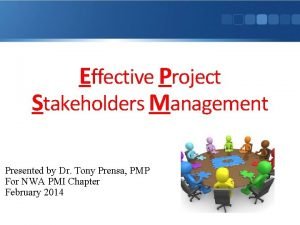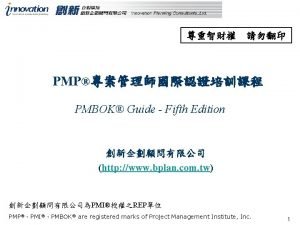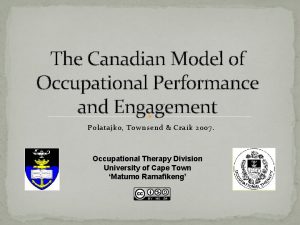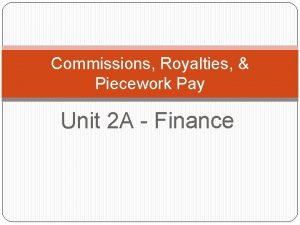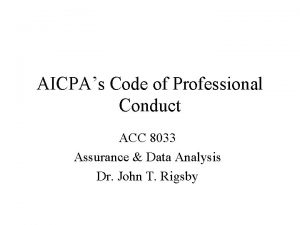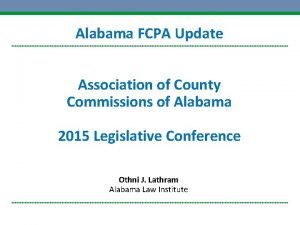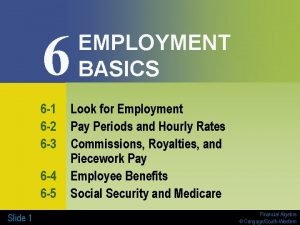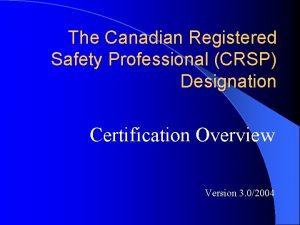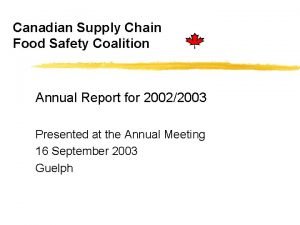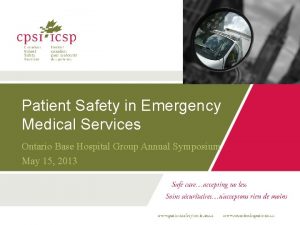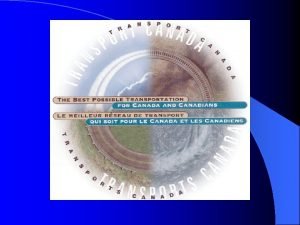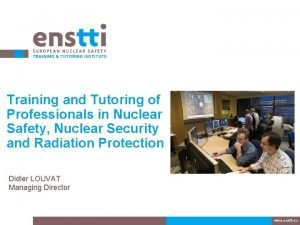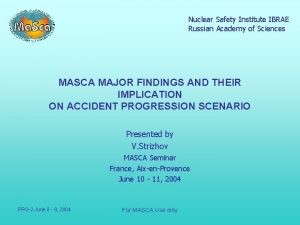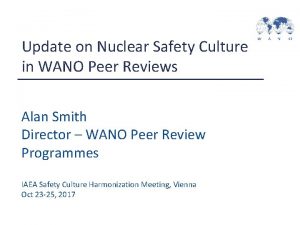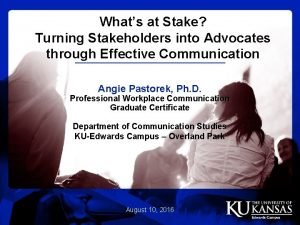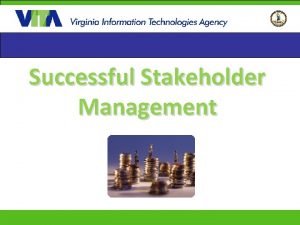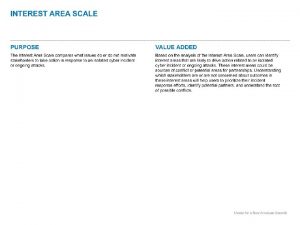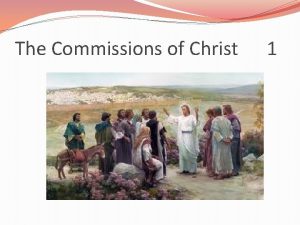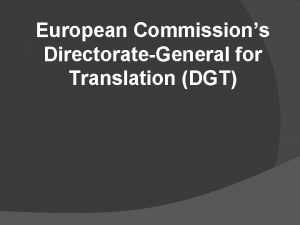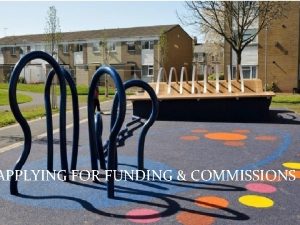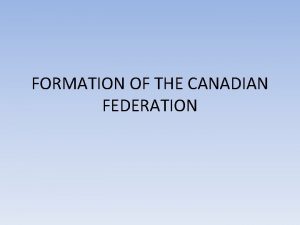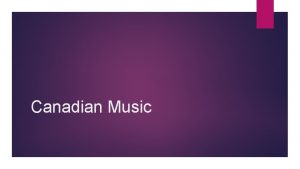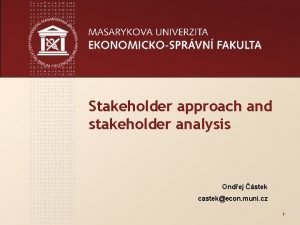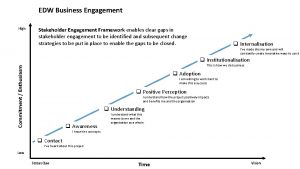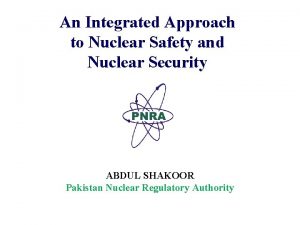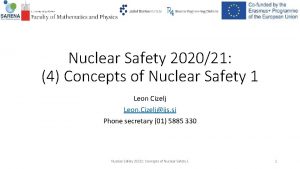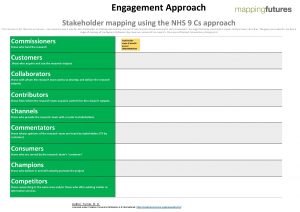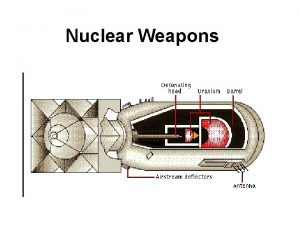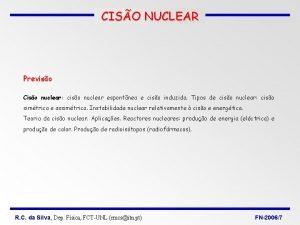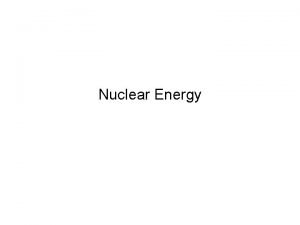STAKEHOLDER ENGAGEMENT The Canadian Nuclear Safety Commissions Approach





























- Slides: 29

STAKEHOLDER ENGAGEMENT The Canadian Nuclear Safety Commission’s Approach and Experience Liane Sauer Director General, Strategic Planning Directorate, Canadian Nuclear Safety Commission Presentation to the 2 nd Nuclear Regulatory Information Conference May 18, 2018 – Johannesburg, South Africa nuclearsafety. gc. ca

The Canadian Nuclear Safety Commission (CNSC) Our Mandate Regulates the use of nuclear energy and materials to protect health, safety, and security and the environment Implements Canada's international commitments on the peaceful use of nuclear energy Disseminates objective scientific, technical and regulatory information to the public Communicating is enshrined in law 2 nuclearsafety. gc. ca

The CNSC Regulates All Nuclear Facilities And Activities In Canada Nuclear research and educational activities Uranium mines and mills Transportation of nuclear substances Uranium fuel fabrication and processing Nuclear security and safeguards Nuclear power plants Import and export controls Nuclear substance processing Industrial and medical applications 3 Waste management facilities nuclearsafety. gc. ca

What is Public Engagement? 4

5 nuclearsafety. gc. ca

Why should Public Engagement Matter to Regulators? 6

Why Does Public Engagement Matter to Regulators? Public engagement ensures that regulators: Make informed decisions 7 Are ready for change nuclearsafety. gc. ca Build trust in the regulatory process

How Canadians Feel About Scientific Facts Question: To what extent do you agree or disagree that scientific findings… Question: Thinking about media coverage you have seen about scientific issues, to what extent do you agree that it is: Question: To what extent are you concerned about each of the following: Source: Leger. Web online survey of 1, 514 Canadians, August 15 -16, 2017 8 nuclearsafety. gc. ca

Who Canadians Trust To Provide Reliable Scientific Information Government Source: Leger. Web online survey of 1, 514 Canadians, August 15 -16, 2017 9 nuclearsafety. gc. ca

Edelman Trust Barometer – Canada 2018 report assessed Canadians’ opinion on the trust and credibility of four institutions: NGOs, business, government and media • From 2017 to 2018, trust in NGOs and business have decreased, while trust in government and media have increased • Trust in government officials / regulators increased by 11% to 37% in 2018 • Since 2014, trust in industry sectors is generally declining, except for energy • 65% in Canada worry about false information or fake news being used as a weapon • Canadians are returning to figures of authority and experts for truth • While trust in journalism from general news and information sources has rebounded since last year, trust in social media and search engines has continued to decline Engagement is necessary now more than ever 10 nuclearsafety. gc. ca

Who does CNSC Engage With and When? 11

CNSC’s Main Engagement Groups Core: • Host communities • Indigenous peoples • Licensees Themed: • Youth • Academia • Medical community • Municipalities 12 nuclearsafety. gc. ca

When do we engage? • On all major projects and initiatives • In accordance with our Domestic Outreach and Engagement Plan • In response to requests and unexpected issues • On changes to our regulatory framework Never too early or often 13 nuclearsafety. gc. ca

How does the CSNC Engage? 14

The CNSC’s Public Engagement Activities EXTENSIVE OUTREACH PROGRAM PARTICIPANT FUNDING PROGRAM (PFP) INDIGENOUS AND PUBLIC CONSULTATION S 15 nuclearsafety. gc. ca REQUIREMENT FOR LICENSEES TO COMMUNICATE

CNSC’s Outreach Activities – In Person In 2016– 17, the CNSC participated in over 120 in -person outreach activities, including: • open houses and meetings related to the deep geological repository initiative for used nuclear fuel • activities in nuclear host communities • youth-related activities • booths at industry conferences An example outreach activity is CNSC 101: • designed to build public understanding of Canada’s nuclear regulatory regime • since CNSC 101 was launched in 2010: 67 sessions, 54 different locations across the country, over 1606 participants Meeting Canadians from coast to coast 16 nuclearsafety. gc. ca

CNSC’s Outreach Activities – Digital Presence Multiple digital tools used: • CNSC website • Government of Canada website (Canada. ca) • emails • webinars • earned media and letters • social media platforms: Twitter, Facebook, You. Tube, and Linked. In Improving public understanding and seeking feedback 17 nuclearsafety. gc. ca

Twitter is used to quickly share the latest news and updates from the CNSC 18 nuclearsafety. gc. ca

Facebook is used to share stories, educational resources, and facts on nuclear safety in Canada 19 nuclearsafety. gc. ca

You. Tube is used to share video content, including Commission proceedings 20 nuclearsafety. gc. ca

Consultations on Regulatory Framework Consultation with the public, Indigenous peoples, licensees and interested organizations is an important part of the CNSC’s regulatory framework development process The CNSC welcomes public input on draft documents that are open for consultation, including : • Proposed regulations • Draft regulatory documents • Discussion papers • Draft standards 21

Consultation With Indigenous Peoples • Canada is home to 1, 400, 685 Indigenous people (4. 3% of the population), there are 617 communities and reserves, and more than 50 Indigenous Nations • Legal duty to consult • Government of Canada’s commitment to reconciliation and a renewed relationship • The United Nations Declaration on the Rights of Indigenous Peoples (UNDRIP) Honour, integrity, good faith and fairness 22 nuclearsafety. gc. ca

CNSC’s Approach to Consultations with Indigenous Peoples • Building positive, long-term relationships • Leading a whole-of-government approach • Understanding and addressing potential impacts • Welcoming participation and the sharing of traditional practices/knowledge and projectspecific concerns • Requiring licensees to engage early and throughout the life of their project Transparency and impartiality 23 nuclearsafety. gc. ca

CNSC’s Participant Funding Program (PFP) Established to give the public, Indigenous groups and other stakeholders the opportunity to request funding from the CNSC to participate in its regulatory processes (annual envelope of approx. $900, 000 or 8, 827, 065 ZAR) Objectives • enhance Indigenous, public and stakeholder participation in the CNSC’s environmental assessment (EA) and licensing process • help stakeholders bring valuable information to the Commission, through informed and topicspecific interventions related to aspects of EA and licensing processes Open for all public Commission hearings and environmental assessments through a funding application process Enabling active participation by all interested parties 24 nuclearsafety. gc. ca

Public Information and Disclosure Program RD/GD-99. 3, Public Information and Disclosure, provides requirements and guidance for public information and disclosure programs (PIDPs) Applies to: • Uranium mines and mills • Class I facilities (nuclear power plants, research reactors and fuel processing facilities) • Certain Class II facilities (pool irradiators and commercial isotope production facilities) All major facilities are implementing their PIDPs 25 nuclearsafety. gc. ca

Public Information and Disclosure Program (continued) Regulatory oversight tools for PIDPs: • Program assessment completed for licence renewal/application • Annual evaluation completed to verify implementation • Inspections for compliance verification Bruce Power’s Summer Bus Tour Program An effective PIDP is a licence condition 26 nuclearsafety. gc. ca

Culmination of Engagement: Independent Commission • Commission hearings and meetings are open to the public, webcast live, and archived • Held in-house or in communities • Written and/or oral interventions • In the last five years, over 80 public hearings and meetings, over 2, 600 submissions • All decisions are released to the public 27 Transparent, science-based decision making nuclearsafety. gc. ca

Challenges Despite the progress made, we continue to face challenges when it comes to public engagement in Canada, including: • The opinions of people who are either strongly for or against nuclear will not change, and it is difficult to capture the attention of the majority of people in the middle • Social media has made it easier for false information to be spread quickly and broadly • Unless there is an emergency, few people turn to the nuclear regulator for information 28 • Engaging in evolving issue areas such as transportation of waste require new approaches nuclearsafety. gc. ca

Connect With Us Join the conversation nuclearsafety. gc. ca
 Graduated commission example
Graduated commission example Iso stakeholder engagement
Iso stakeholder engagement Managing stakeholder engagement
Managing stakeholder engagement Pmp stakeholder engagement plan
Pmp stakeholder engagement plan Cmope model
Cmope model Lesson 15 nuclear quest nuclear reactions
Lesson 15 nuclear quest nuclear reactions Fisión nuclear vs fision nuclear
Fisión nuclear vs fision nuclear Who are the business stakeholders
Who are the business stakeholders 5-3 commissions royalties and piecework pay answers
5-3 commissions royalties and piecework pay answers 5-3 commissions royalties and piecework pay
5-3 commissions royalties and piecework pay 5-3 commissions royalties and piecework pay answers
5-3 commissions royalties and piecework pay answers What is immediate family considered
What is immediate family considered Fcpa alabama
Fcpa alabama Janice earns $3 750
Janice earns $3 750 What is a crsp certification?
What is a crsp certification? Canadian supply chain food safety coalition
Canadian supply chain food safety coalition Canadian patient safety officer course
Canadian patient safety officer course Canadian motor vehicle safety standards
Canadian motor vehicle safety standards Nuclear safety training
Nuclear safety training Nuclear safety institute of the russian academy of sciences
Nuclear safety institute of the russian academy of sciences Nuclear safety culture
Nuclear safety culture Vc vs datagram
Vc vs datagram Cognitive approach vs behavioral approach
Cognitive approach vs behavioral approach Waterfall vs shower approach
Waterfall vs shower approach Multi approach avoidance conflict
Multi approach avoidance conflict Bandura's reciprocal determinism
Bandura's reciprocal determinism What is research approach definition
What is research approach definition Traditional approach of development
Traditional approach of development Tony wagner's seven survival skills
Tony wagner's seven survival skills Definitive stakeholder
Definitive stakeholder


